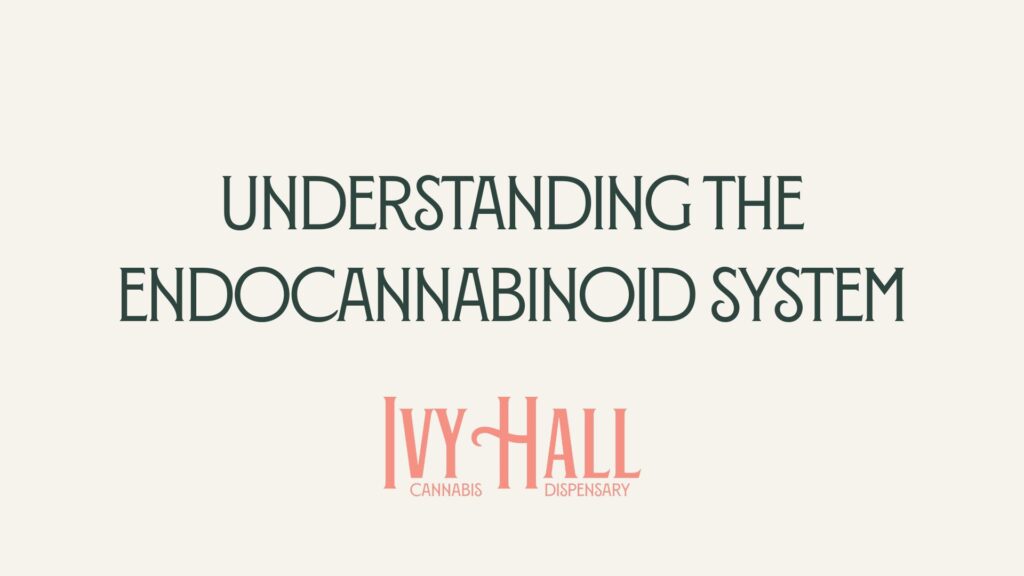The endocannabinoid system, or ECS, is a vital biological network of receptors and responses that exists in humans and most other animals. While some people hear the term “cannabinoid” and tune out, assuming we’re merely referring to the biological and chemical systems that get someone “high” off cannabis, this is a massive underestimation of the endocannabinoid system’s power and importance. In reality, the ECS helps regulate everything from mood to pain perception to sleep patterns.
Some cultures have understood parts of the endocannabinoid system, on at least some level, for thousands of years, allowing the ancients to unlock cannabis’s significant medicinal potential long before the dawn of modern medicine. However, the reality for most is that the ECS is a complex and difficult-to-understand network of interconnected biological and chemical reactions. As its importance becomes increasingly evident, medical professionals and scientists have spent years, and even entire careers, just developing an understanding of the human ECS.
Thankfully, the public health climate, spurred by research like this National Academies of Science evidence review of cannabinoids, has improved greatly over the past few decades. Today, we’ll endeavor to learn about cannabinoids and the ECS and some of the key health factors they can help us regulate.
The Role of the Endocannabinoid System in the Body

The endocannabinoid system (ECS) is best understood as a regulatory network that plays a crucial role in maintaining homeostasis, a wellness concept referring to an all-encompassing “balance” within the body. The ECS achieves this homeostasis by influencing various physiological functions, stabilizing them against internal fluctuations and outside stimuli alike.
So, which physiological functions are we specifically talking about when we refer to this connection between homeostasis and cannabis? You may be surprised to learn that the ECS plays a role in just about every important process you can think of, whether directly or indirectly, through one of the following.
Some of the key processes that your endocannabinoid system helps to regulate include:
- Mood – The ECS helps modulate important aspects of your mood, such as your stress response, leading to an overall sense of well-being and emotional stability.
- Immune System – The ECS plays a part in balancing and stabilizing the immune system.
- Appetite and Digestion – An effect already well-known by many a cannabis fan, signals sent through the ECS play a key role in provoking feelings of hunger.
- Pain – The ECS can modulate pain signals and influence inflammatory responses, potentially battling pain through multiple distinct functions.
- Sleep – The ECS also appears to regulate sleep rhythms. Positive interactions with the ECS can mean some compounds may help you develop an effective sleep hygiene regimen or just get better quality sleep after a challenging day.
In light of all these key connections between important health factors and the endocannabinoid system, the potential connection between homeostasis and cannabis itself becomes more difficult to deny, even for the most cynical anti-cannabis crusader. While we still don’t know everything about how cannabis affects the body, recent ECS research has been both prolific and promising.
Components of the ECS: Receptors, Endocannabinoids, and Enzymes
By now, you’re probably starting to realize that the endocannabinoid system (ECS) is a complex and multifaceted concept. To help better understand its fundamental mechanics, researchers like those contributing to Biological Psychiatry: Cognitive Neuroscience and Neuroimaging break it down into three core components: cannabinoid receptors, enzymes, and endocannabinoids themselves.
Endocannabinoid Receptors
While various chemical receptors throughout the body’s various systems may be affected by the consumption of cannabinoids like THC and CBD, today, we’ll focus on two key types of ECS receptors: the aptly named CB1 and CB2 receptors.
- CB1 – CB1 receptors are mostly found in the brain and throughout the other elements of the central nervous system, or CNS. The CNS plays a major role in how people experience the effects of most recreational drugs, and it is likewise responsible for the psychoactive “high” associated with THC consumption.
- CB2 – CB2 receptors, meanwhile, are found in many of the different organs associated with, and peripheral to, the immune system. While not so much implicated in the classic psychoactive elements of cannabis use, these CB2 receptors are still key to important medicinal responses sought by therapeutic cannabis users – the significant anti-inflammatory properties of CBD being just one example.
Endocannabinoids
You may already be aware of cannabinoids like THC and CBD and their long list of cousins and variants. In fact, in the cannabis plant alone, over 100 different cannabinoids have been identified to date.
Endocannabinoids are functionally similar to plant-based cannabinoids (phytocannabinoids) and can be thought of as special cannabinoids that your body produces naturally. That’s right, everyone you’ve ever met is being affected by endocannabinoids all of the time, throughout their entire life, whether or not they’ve ever taken a single puff of cannabis. The key distinction between endocannabinoids vs. phytocannabinoids is where they come from. While there are many similarities between the functions and effects of these two types of cannabinoids, phytocannabinoids come from cannabis plants, whereas endocannabinoids are produced by the body.
There are two specific endocannabinoids that seem to be most important to human function and have, therefore, been studied the most to date.
This powerful pair is made up of:
- Anandamide (AEA) – Discovered in the early 1990s, anandamide is considered a “weak agonist” for both CB1 and CB2 receptors, which means that it binds to and interacts with both types of receptors to create biological changes but prefers the CB1 receptor. This makes sense, given its association with euphoric mental effects.
- 2-Arachidonoylglycerol (2-AG) – This endocannabinoid plays an important role in regulating the body’s immune system and inflammation response.
Enzymes
Enzymes are special proteins that act as catalysts (compounds that increase or speed up a chemical reaction) for a number of important biological processes. Enzymes play a key role in the ability of certain molecules to bind to receptors within your body.
Enzymes closely associated with the ECS are:
- Fatty Acid Amide Hydrolase (FAAH) – After anandamide molecules have served their purpose, FAAH continues to break them down for elimination through the body’s other systems.
- Monoacylglycerol Lipase (MAGL) – MAGL plays a role in the steady degradation of 2-AG molecules, keeping the endocannabinoid system sustained and well-regulated.
How Cannabis Interacts with the Endocannabinoid System

Let’s zoom in on some of the ways cannabis consumption can be used to “hack” your endocannabinoid system. THC vs. CBD effects on the ECS are an important focus, but we will also touch on some other, less prominent cannabinoids.
THC and the ECS
At this point, you may be beginning to better understand some of the links between cannabinoids and homeostasis; you may have even put the pieces together and surmised that THC and anandamide play similar roles. It is true that both bind primarily to CB1 receptors, resulting in powerful psychoactive effects that can range from a subtle sense of well-being to a euphoric, cerebral “high.” In fact, for people who may not produce enough anandamide naturally, THC can mimic its effects by binding to those same CB1 receptors that are prepared to bind with natural anandamide.
If you prefer THC-heavy cannabis for this reason, you’ll be happy to learn that you can filter products by THC potency so you only see the heaviest hitters.
CBD and the ECS
Unlike THC, CBD does not appear to bind directly to CB1 and CB2 receptors and, therefore, cannot mimic 2-AG in quite the same way THC mimics anandamide. CBD’s influence on endocannabinoid receptors is indirect and happens through interaction with the FAAH enzymes we mentioned earlier.
CBD and FAAH work together to reduce inflammation, but this isn’t the only function of CBD within the ECS. Remember that complex interplay between different cannabis compounds that we’ve touched on a few times? It turns out CBD is also important for tempering and extending the effects of THC (or natural anandamide) metabolization. This can lead to a more pleasant and consistent cannabis experience and a reduction in the unpleasant side effects some cannabis users experience, such as increased anxiety.
If you’re interested in a less psychoactive cannabis experience, then you can filter your cannabis product search to focus on CBD-rich products.
Other Cannabinoids: CBG, CBN, and More
Lesser-known cannabinoids like CBG and CBN also influence the endocannabinoid system in unique and subtle ways. There is a wealth of research and discussion, including a compilation from Harvard Health, available on the so-called “minor” cannabinoids, as well as many different, high-quality cannabis products to try that focus on these compounds.
Some prominent examples include:
- CBG (Cannabigerol) – CBG appears to contribute to cannabis’s well-known anti-inflammatory effects.
- CBN (Cannabinol) – This compound appears to interact with the ECS to promote relaxation and sleep.
- THCV (Tetrahydrocannabivarin) – This compound has shown promise for treating obesity and diabetes because it may improve glucose levels and modulate pancreatic cells that produce insulin and other related hormones.
Together, these and other cannabinoids – along with terpenes, flavonoids, and other compounds – contribute to the “entourage effect.” This interplay of compounds with the ECS may mean that cannabis strains can be an effective supplement for improving health.
Fortunately, many cannabis products on the market today provide a full-spectrum experience that includes all of the same natural cannabinoids found in pure cannabis flower.
The ECS, Cannabis, and Health Benefits
Cannabis and cannabinoids appear to interact with the ECS to address chronic pain, anxiety, sleeplessness, and other issues, but it is also quite possible that ECS dysfunction could be the root cause of these issues in the first place.
The links between cannabis and health are complicated, and further research is always warranted, but at this point, it’s fairly safe to say two things:
- The endocannabinoid system’s health is key to overall health. This is important in its own right and also warrants a greater emphasis on scientific research in the area of ECS and medical marijuana.
- Cannabis consumption can impact the performance of the ECS, acting as a substitute or catalyst for natural endocannabinoids.
FAQs About the Endocannabinoid System

Now that you know more information about the ECS, it’s time to consider some of the most frequently asked questions about this fascinating system.
Can You Naturally Support Your ECS Without Cannabis?
Yes! Exercise and stress management can be great ways to help regulate any bodily system, including the ECS. Getting plenty of omega-3 fatty acids through your diet or supplement regimen is an especially good way to support overall ECS health.
Why Do Some Strains Feel Different From Others?
While researchers published in Experimental and Clinical Psychopharmacology found that nearly all cannabis enthusiasts polled experience significant differences in indica and sativa strains, the mechanisms behind this are a hotly debated topic. Strain differences are the subject of much ongoing research and a topic that could make for an extensive discussion all on its own. To keep it as simple as possible, different THC-to-CBD ratios, the levels of other cannabinoids, terpene profiles, and the method of consumption can all influence how cannabis strains interact with the ECS.
Does Everyone Respond to Cannabis the Same Way?
Each person’s unique body, mind, current setting, and previous cannabis history will all play a factor in how they experience a particular strain. Factors like genetics, cannabis tolerance, and ECS sensitivity could affect each individual’s experiences with cannabis, meaning that results can be quite different from person to person and sometimes even from session to session when experimenting with different types of cannabis products.
Because of these factors, it can be hard to predict how cannabis affects the body differently from person to person. That’s why most cannabis experts recommend starting with a small dose of cannabis and allowing ample time before redosing when you’re trying a new cannabis product for the first time. Also, consider experimenting with different products and consumption methods until you have dialed in the optimal cannabis experience for your unique needs.
Cannabis effects and tolerance to cannabis can especially become an issue for therapeutic cannabis enthusiasts who may want to use cannabis on a routine basis without the effects lessening over time. Gradually increasing your cannabis intake to increase the effects can work for a time, but planning “tolerance reset” breaks (when your symptoms allow it) is also a great strategy.
Why Understanding the ECS Matters for Cannabis Users

A better understanding of the endocannabinoid system empowers consumers who want to make informed choices about cannabis products. By knowing a little bit more about just how cannabis interacts with your mind and body, you can feel more confident making choices about your own cannabis consumption, whether you’re a long-time cannabis enthusiast or a first-time shopper.
Visit your friendly neighborhood Ivy Hall dispensary for any and all of your cannabis needs. Whether you’re looking for premium flower, searching for delicious edibles, or just have a question about how it all works, we’re here to help you have a fabulous sensory experience. Stay tuned for more as we continue to foster the budding relationship between Chicago and the retail cannabis industry to create a healthy and safe experience for everyone involved.
Resources:
- National Center for Biotechnology Information. (2017). Citing Medicine: The NLM Style Guide for Authors, Editors, and Publishers (2nd ed.). National Library of Medicine (US). https://www.ncbi.nlm.nih.gov/books/NBK425767/
- Piomelli, D., & Russo, E. B. (2020). The Cannabis sativa versus Cannabis indica debate: An interview with Ethan Russo, MD. Biological Psychiatry: Cognitive Neuroscience and Neuroimaging, 5(6), 464–471. https://doi.org/10.1016/j.bpsc.2020.07.016
- Grinspoon, P. (2021, March 23). Beyond CBD: Here come the other cannabinoids, but where’s the evidence? Harvard Health Blog. https://www.health.harvard.edu/blog/beyond-cbd-here-come-the-other-cannabinoids-but-wheres-the-evidence-2021032322190
